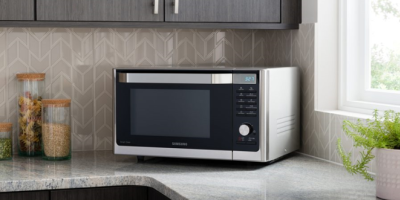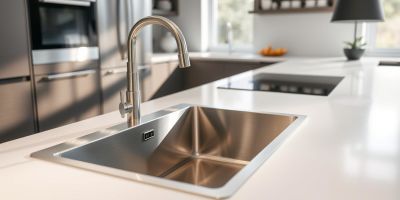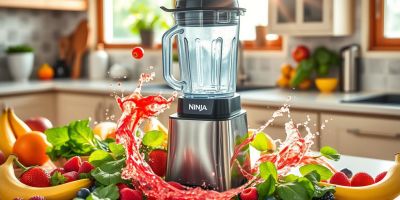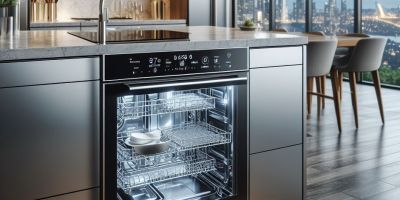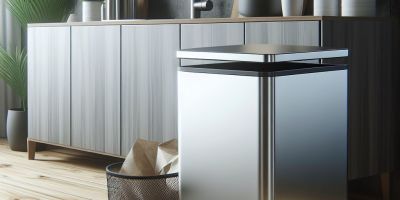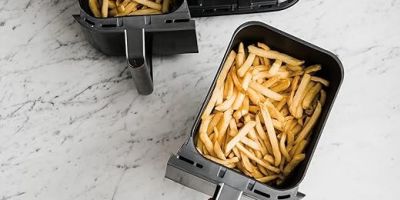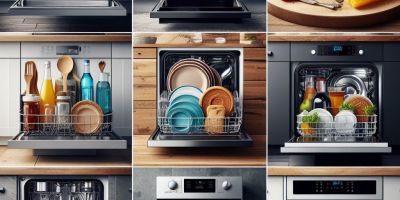2024-10-07 09:17:02 |
Key Takeaways
- Kitchen sinks come in diverse materials, each with unique benefits
- Consider your kitchen size and usage when selecting sink dimensions
- Durability varies among materials, with composite quartz and ceramic leading the pack
- Stainless steel sinks offer great value and versatility
- Many brands provide lengthy guarantees, ensuring long-term satisfaction
- Free delivery is often available for orders over £250 in the UK
- A 90-day exchange window allows you to ensure the perfect fit for your kitchen
Understanding Kitchen Sink Basics
The kitchen sink is key in any home. It's at the heart of kitchen plumbing, vital for food prep, cleaning, and daily tasks. When picking a sink, think about both function and style.
The Role of Kitchen Sinks
Today's kitchen sinks do more than wash dishes. They're central for food prep, cleaning, and even watering plants. A good sink can make your kitchen work better and cooking more enjoyable.
Key Selection Factors
When choosing a sink, remember these:
- Material durability
- Size and depth
- Bowl configuration
- Installation type
Stainless steel sinks are durable against heat and stains. Granite composite sinks are tough and scratch-resistant. Cast iron sinks with a porcelain enamel finish add a classic touch.
Balancing Form and Function
Your sink should match your kitchen's look and meet your needs. Consider a built-in drainer if you don't have a dishwasher. Single basin sinks are perfect for big pots, while double basins offer more flexibility. Choose a depth and height that fit your cooking style.
Types of Kitchen Sink Mounts
Choosing the right kitchen sink is important. The mounting style affects both how well it works and how it looks. Let's look at the main types of sink mounts to help you pick the best one for your kitchen.
Inset Bowls: Versatility and Ease of Installation
Inset bowls, or drop-in sinks, are the most common choice. They sit on top of the worktop with a visible rim. This makes them easy to install and versatile, fitting well with many countertop materials like laminate and granite.
Undermount Sinks: Creating a Streamlined Look
Undermount sinks are installed under the worktop, giving a clean, modern look. They're easy to clean because there are no edges to catch dirt. Though they cost more to install, they offer a sleek look and come in materials like stainless steel and ceramic.
Belfast Mounts: A Statement Piece for Traditional Kitchens
Belfast sinks, also known as farmhouse or apron sinks, are eye-catching in traditional kitchens. They have an exposed front wall and are big enough for washing big pots and pans. While they might be more expensive, they bring charm and character to any kitchen.
Each type of sink has its own benefits. Inset bowls are versatile, undermount sinks are sleek, and Belfast mounts are traditional. Think about your kitchen's style, budget, and needs to find the perfect sink.

Exploring Kitchen Sink Bowl Configurations
When designing your washing up area, the bowl configuration is key. Kitchen sinks come in various layouts to fit different needs and spaces.
Single bowl sinks are great for smaller kitchens or those who like a clear workspace. They can be up to 33 inches wide, making room for big pots and pans.
1.5 bowl sinks are perfect for those who want flexibility. The main bowl is for washing, and the smaller half-bowl is great for food prep or quick rinses.
Double bowl sinks are ideal for multitasking. They can be up to 48 inches wide, offering separate areas for washing and rinsing. This is great for busy homes where many people use the sink at once.
When picking your sink configuration, think about:
- Available counter space
- Your cooking and cleaning habits
- The size of your usual cookware
The right bowl configuration can make your kitchen sink more efficient. It can turn it into a tailored washing station that improves your daily kitchen routines.
Materials Matter: Choosing the Right Sink Material
Choosing the right sink material is key for your kitchen's look and function. Let's look at three popular options that are both durable and stylish.
Stainless Steel: Durability and Versatility
Stainless steel sinks are a favourite in UK homes. They're affordable, starting at £50-100, and top-end ones can cost up to £400. These sinks are great because they don't rust or stain easily, making them simple to clean. Plus, they can handle high heat, perfect for kitchens that are always busy.
Ceramic: Classic Charm and Longevity
Kitchen sink ceramic units add a timeless beauty to your kitchen. They cost from £150, with some high-end ones over £400. These sinks are durable and don't chip easily. They also handle heat well. However, they're heavy, so you'll need to plan carefully when installing them.
Granite Composite: Modern Luxury and Resilience
Granite composite sinks mix modern style with practicality. Prices start around £150, with many finishes to choose from. These sinks are tough against heat, stains, and scratches. They're also good at keeping bacteria and smells away, making them ideal for clean kitchens.
Colour Considerations for Your Kitchen Sink
Colour is key when picking a kitchen sink. The right colour can make your kitchen look amazing. It should match your kitchen's style perfectly.
White sinks are always in style. They look clean and bright, fitting many kitchen designs. Stainless steel sinks are also popular. They're strong and modern, matching many appliances well.
Black sinks are becoming trendy for their elegance. They hide marks and stains well. Gold sinks add luxury, great for fancy or vintage kitchens.
- White: Timeless and easy to clean
- Stainless steel: Durable and versatile
- Black: Sophisticated and hides stains
- Gold: Luxurious and warm
The sink's colour affects how clean your kitchen looks. Light colours show stains easily, while dark ones hide them. Think about how the colour will look with your kitchen's other elements.
The sink's colour can also affect your home's value. Choosing colours that are timeless and appealing can attract buyers. Pick a colour that you like and that makes your kitchen look great.
Size and Depth: Finding the Perfect Fit
Choosing the right size and depth for your kitchen sink is key. It should match your kitchen plumbing and fit well in your counter space.
Determining the Ideal Sink Size
Kitchen sinks usually range from 22 to 30 inches long and 24 to 25 inches wide. Single-bowl sinks are great for small kitchens. Double-bowl sinks are better for bigger spaces. If you often deal with large pots and pans, look for a sink up to 33 inches long.
The Importance of Sink Depth
Sink depth is crucial for practical use. Most sinks are 8 to 10 inches deep. But, you can find deeper ones too. Deeper sinks make cleaning tall items easier and can hide dirty dishes. Just remember, they might need more water to fill.
Balancing Sink Size with Counter Space
Think about your counter space when picking a sink. Kitchen cabinets come in 3-inch increments, from 18 to 36 inches. For laminate countertops with a backsplash, you can install a sink up to 20.5 inches deep. Without a backsplash, it's up to 22 inches. Make sure there's enough room around your sink for food prep and other tasks.
- Single-bowl sinks: Ideal for smaller kitchens or uninterrupted washing
- Double-bowl sinks: Offer separate areas for washing and rinsing
- Wider sinks: Can accommodate larger cookware
By carefully considering these factors, you can find a kitchen sink that perfectly fits your space and meets your needs.
Kitchen Sink Styles to Complement Your Décor
Choosing the right sink can change your kitchen's look. There's a style for every décor, from traditional to modern. Farmhouse sinks add a bold touch to rustic kitchens with their deep basins.
Sleek undermount sinks bring a modern look, creating a seamless finish. Kitchen sink ceramic options add classic charm. They're handcrafted and fired in high-temperature ovens for durability.
Stainless steel sinks are a top choice for chefs. They're heat-resistant and easy to clean, perfect for busy kitchens. For a luxurious feel, consider copper or gold-finished stainless steel sinks. They're popular in high-end kitchen designs.
Composite sinks are durable, made from quartz and other materials. They offer a robust finish. Remember, your sink should match your worktops and cabinets.
- Inset sinks: Versatile and easy to install
- Undermount sinks: Provide a smart, seamless finish
- Integral sinks: Offer a smooth, continuous surface
- Flush-mounted sinks: Perfect for minimalist designs
A Belfast sink looks great with wooden counters in a country-style kitchen. For a modern look, pair an undermount sink with sleek granite surfaces.

Additional Features to Enhance Your Sink Experience
Kitchen sinks have changed a lot. They now come with extra features to make your daily tasks easier. Let's look at some features that can make your sink better and your kitchen plumbing more efficient.
Built-in Drainers: Convenience at Your Fingertips
A built-in drainer is very useful. It gives you a special place to dry dishes. Many sinks have reversible drainers for both left and right-handed people. This makes your worktop cleaner and more organised.
Integrated Waste Disposal Units: A Clean Solution
Waste disposal units are becoming more popular in UK homes. They grind food waste and flush it away. This makes cleaning up easier and reduces bad smells. Make sure your kitchen plumbing can handle the unit.
Tap Hole Configurations: Ensuring Compatibility
The number and where tap holes are matters a lot. Single-hole sinks fit modern mixer taps. Three-hole sinks work with separate hot and cold taps and a spout in the middle. Pick a style that matches your tap and kitchen look.
Think about adding features like built-in chopping boards or colanders. These can make your sink more useful and save space under the sink. Choose features that fit your cooking style and lifestyle for a kitchen that's just right for you.
Maintenance and Care Tips for Your Kitchen Sink
Keeping your kitchen sink clean is key for a hygienic kitchen. Studies show sinks can have more bacteria than toilet bowls. So, regular maintenance is a must. Let's look at some easy tips to keep your sink clean and germ-free.
For stainless steel sinks, clean them daily with hot, soapy water. Wipe the surface after each use to stop water spots and stains. Composite sinks need the same care, using a soft cloth to avoid scratches.
Ceramic sinks, made from premium fireclay, have a non-porous surface that resists stains. Clean them with mild detergent and warm water. For tough marks, try a mix of borax and lemon juice.
- Disinfect your sink every other day to eliminate harmful bacteria
- Use baking soda, vinegar, or diluted bleach as natural disinfectants
- Allow the sink to dry thoroughly to prevent bacterial growth
Don't pour grease down the drain as it can cause clogs. Start a compost pile for food scraps instead. This stops drain problems and helps the environment.
Remember, sink care is not just about the basin. Clean taps quickly and use heat-resistant mats on worktops. With these tips, your kitchen sink will stay functional and clean.
Budget Considerations: Finding Value for Money
When planning your kitchen renovation, budgeting for a sink unit is key. Allocate about 5% of your total kitchen budget for the sink and tap. This balance ensures quality without overspending.
Kitchen sinks vary in price. Stainless steel sinks are often a good deal. Ceramic or composite sinks might cost more. Think about durability, maintenance, and warranty when choosing.
- Long-term durability
- Maintenance costs
- Warranty periods
Stone or copper sinks can make your kitchen stand out. But, make sure they fit your home's value. For example, a £75,000 home might not see a big return from a £20,000 kitchen update.
A new kitchen can boost your property's value by up to 10%. Choose wisely to get a sink that's both functional and stylish. This way, you'll enjoy a great kitchen without spending too much.
Conclusion: Making the Right Choice for Your Home
Choosing the right kitchen sink is key for both function and style. Sinks vary in size, from 24 to 36 inches wide and 8 to 10 inches deep. They come in different styles, like single basins or split ones, to fit your needs.
The material of your sink matters a lot. Stainless steel sinks are tough and can handle heat well. Granite composite sinks can even handle temperatures up to 535°F. Porcelain or cast iron sinks give a classic look and are great at blocking out noise.
Think about how the sink will fit into your kitchen. Top-mount sinks are simple to put in, while undermount ones look sleek. Farmhouse sinks are great for washing big items. By considering these points, you can pick a sink that makes your daily life better and looks good in your home for years.
FAQ
What is the role of a kitchen sink in modern homes?
Kitchen sinks are key in food prep, cleaning, and kitchen function. They do more than just wash dishes, making them vital in any home.
What key factors should I consider when choosing a kitchen sink?
Think about material durability, size, and bowl setup. Also, consider installation type, budget, and décor style. It's important to find a balance between function and looks.
What are the different types of kitchen sink mounts?
There are inset, undermount, and Belfast sinks. Each has its own benefits and things to consider.
What are the different bowl configurations available for kitchen sinks?
Sinks come in single, 1.5, and double bowl setups. Pick one that fits your needs and space.
What are the popular materials used for kitchen sinks?
Stainless steel, ceramic, and granite composite are popular. Think about heat, scratch resistance, and upkeep when choosing.
What colour options are available for kitchen sinks?
Sinks come in white, silver, grey, and black. Pick a colour that matches your kitchen's style.
How do I determine the right size and depth for my kitchen sink?
The sink's size and depth should match your kitchen. Consider your cookware, washing habits, and counter space. Deeper sinks hide dishes but use more water.
What are some additional features that can enhance my sink experience?
Features like built-in drainers and waste disposal units can be helpful. Think about your kitchen use when choosing these.
How do I properly maintain and care for my kitchen sink?
Follow the maker's cleaning tips and avoid harsh cleaners. Regular cleaning keeps your sink looking good.
How do I find a kitchen sink that offers good value for money?
Look at durability, maintenance costs, and warranties. Stainless steel is affordable, but ceramic and composite may cost more. Find a balance between price and quality.

















